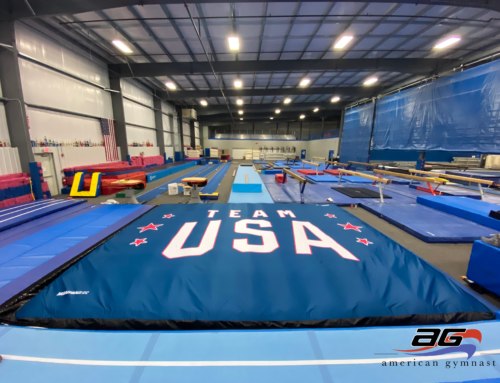How to deal with balking…
If you’re a gymnastics coach, you immediately know what I mean when I use the word “balk.” It can be a coach’s worst nightmare. A gymnast develops a fear of a skill – sometimes a completely irrational one – and one time becomes scared enough to actually abort the skill before even attempting it. Common examples include dismounts off of high bar/uneven bars, release moves, backward tumbling skills on floor, and just about any skill on beam. Balking once or twice isn’t what drives the coach crazy…it’s the fact that balking becomes a habit that tends to get worse and worse if it’s allowed to continue. A gymnast may at first balk about 1 out of every 10 attempts, then soon this becomes 1 out of every 5, then 1 out of 4, 1 out of 3…and then half the time. Often this trend continues to the point where the gymnast simply has psyched himself or herself completely out and won’t go for the skill at all. These situations typically involve a lot of tears, intense frustration from both coach and athlete, and an incredible level of anxiety. These situations very often escalate to the point where parents become involved, as the child may come home crying or simply unhappy, and conferences often ensue. It’s not too uncommon for a gymnast to quit the sport altogether because of ONE intense fear that has slowly developed into an overgrown MONSTER inside the gymnast’s head.
The topic is on my mind because I coach a kid who has begun balking more and more frequently while doing a roundoff, back handspring, back tuck on floor. He has never crashed or hurt himself on the skill. His back handsprings are great – in fact he should be doing the “bonus” in the routine, which is two back handsprings into the back tuck. It is only in practice where he balks…he has thrown the skill just fine in every competition. But as their state meet approached last weekend, the balking suddenly became much worse. What does a coach do?
With this kid in particular I was able to find a solution that worked well, at least for now! He ended up getting his confidence back just in time for the state meet, and during the two-day meet did the best ones he has ever done. Although I certainly haven’t found that “magic solution” to every kid who develops fears like these, here are the steps I have learned to be very important to take:
1. Be honest with myself as a coach as to why the kid may be scared. He may, in fact, have a very logical reason to be worried about the skill. Is he lacking some strength necessary to do the skill easily? Have I rushed him into doing this skill on his own? Has he crashed on the skill before, or watched a friend crash on the skill?
2. I take the gymnast aside and speak to him in private about why he is balking. Doing this in front of his teammates can be a bit embarrassing and make him resent and resist me, and I want the gymnast to know I am on his side. I ask him what would make him feel more comfortable in doing the skill – such as spotting him or at least standing there, or going back to a progression. If he does in fact seem to feel unready, I make it clear that it is totally fine to take these steps, because his confidence in doing the skill is essential.
3. If the gymnast has done the skill many times previously successfully and suddenly begins balking (as my gymnast was doing), we have a bit of a different issue. There is something going on in the gymnast’s head, and it’s important to get him to be open with me about what it is. Just as in the other scenario, I take the gymnast aside and talk to him without showing him stress or frustration. I tell him that I really would like to know what specifically he is afraid of so that we can overcome the problem. Often times boys can be a bit reluctant to admit they are scared, but they’re more likely to show this type of denial in front of the other boys. Talking to him in private and really getting down on their level can really help get him to be honest with you.
4. Sometimes, there is NO logical explanation for why the gymnast is scared. They may not be able to put it into words, or simply may not understand it fully themselves. I believe the BALKING ITSELF is often what scares kids, and they lose faith in themselves about whether they will actually go for it…and they may not be able to voice this. It’s important to remember as a coach that this is very common, very natural, and may not be related at all to something that either of you has done wrong. It’s simply something the mind does as a result of flipping, twisting, and going upside down in the crazy ways this sport requires, and can be compounded when other issues are going on inside the gymnast’s head as well. It’s okay to not be able to explain it.
5. I try not to make a huge deal about it. Even smiling or laughing instead of showing your frustration can convey to the kid that you’re not overly concerned or upset about it.
6. Find AS MANY ways to do the skill (or a progression for the skill) as you can where the kid will actually do it, no matter what it is. This could mean spotting the kid even though he or she doesn’t really need it. It could mean going back to an easier stage of the skill (tumble tramp, putting a sting mat on the floor, using a floor beam or a padded beam). It could mean doing a progression for the skill they have already mastered, or even coming up with a new progression or drill. Find SOMETHING the kid can do without balking, and do lots of them. The goal is to prevent them from balking to try to undo this habit, and to reinforce the idea in the kid’s head that doing the skill is MUCH more rewarding than balking. Balking can be terrifying, and we want to INCREASE the repetitions of going for some form of the skill, and DECREASE even the opportunities of balking on it.
7. Remember to continue not to show frustration. Continue to be positive and willing to try multiple different ideas if something’s still not working. Showing frustration will simply throw another stressor into the kid’s head, which is most likely already overloaded.
I’ve really started to appreciate the fact that the balking itself can be very frightening. The kids know that balking while upside down or in the middle of a series on beam could cause them to land on their head and could have disastrous consequences. Because they’ve begun balking more, THEY BEGIN TO LOSE TRUST IN THEMSELVES, and this is why I believe they begin balking at an earlier and earlier stage of the skill – to avoid even approaching the point where the balking could occur. The kid I coach used to balk after the back handspring and would simply rebound. Then he began killing the back handspring by bending his arms so he couldn’t even do the rebound. Then he began stopping after the roundoff, and pretty soon during the hurdle. Finally, he even began stopping after taking about two steps into the pass!!! And he would even balk with my spotting all of a sudden, which told me there were some serious trust issues going on! Of course I wanted to scream at times, but what finally worked was this: I stopped showing any frustration at all. During one practice while he was balking, I pretended to “forget” we were even doing floor and called him over to join another kid on mushroom. I completely dropped it and acted happy. He was so relieved that he did the best mushroom I had ever seen him do. I went back to tumble tramp and let him “take charge” of how many he wanted to do. I watched from a distance instead of standing right there, and he began calling me over to watch them. I told them how good they looked and was just extremely positive.
That same day we went back to floor and did some roundoff, back handspring rebounds and told him how high his rebounds looked. I told him they were the highest I’d ever seen him do. I told him I wanted HIM to tell me when he was ready to do it. When he came over to tell me, I was relieved, but a little nervous at the same time (but of course didn’t show it). I told him I was ONLY going to spot him that day and that we didn’t even need for him to do any without me there that day…I didn’t want him to be worried that if he did it with me spotting, I would then ask him to do it alone. I made it clear he wouldn’t be doing any on his own that day. I also told him I KNEW he would do it in the meet and that I wasn’t worried about it. My goal was just to get him to do SOME – even with a spot – and not even give him the chance to go back to balking again. When I stood there to spot he did the highest ones he had ever done, and I made sure to tell him. We did three, and ended the practice right there on a really positive note. He did it in the meet – both warm-ups and competition – with no problem at all.
Although some situations can get more difficult than this one, I really believe sticking to these principles helped this kid overcome this somewhat bizarre fear, at least temporarily. If it comes back, I’ll be ready to go through these steps again.
Have you experienced similar challenges with balking? If so, please share what tactics have worked for you!



Leave A Comment